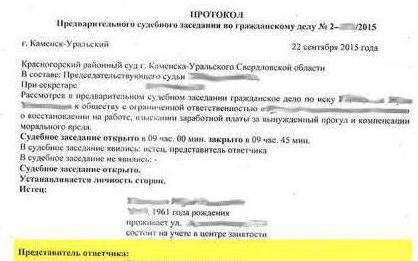The record of the court session is a means of fixing the trial. It reflects the actions of the court and the parties in the process. Due to the fact that it has the status of an official document, a number of requirements are presented to it.
Legislation
The main normative act on the protocol is the Code of Civil Procedure, chapter 21. The judicial department issued instructions for clerical work in the courts, it sets out additional requirements for the execution of the protocol, in particular, the order contains a sample of the protocol of the court session.
Changes to the procedural laws were adopted, and presumably from 2018 in the courts the protocols will be in the form of video and audio recordings. Given the nuances of a technical and material nature, the time period for entry into force of the norm may be postponed.
Protocol application
The record of the court session is required for any civil process. The exception is judicial procedures that do not imply the direct participation of the parties. In particular, we are talking about a court order, a simplified form of production.
Some stages of the general procedure also exclude the maintenance of a protocol, for example, a decision on an application for interim measures if it is considered without participants in the process. Exceptions are expressly stated in law.
Protocol value
The protocol of the court session is an integral part of the trial, therefore, its importance should be taken into account. So, for example, the parties in the complaints refer to the application of certain petitions, but they were not submitted in writing and were not noted in the minutes. This means that this argument is not acceptable to the judges of the court of appeal. The applicant is unable to provide evidence of his claim.

The only way to exclude the possibility of entering false information in the protocol or, conversely, to exclude anything from it is to file a written application with the court. The task of the representative of the party is to ensure that the arguments are as complete as possible on paper.
And in addition, the lack of a protocol is the basis for the annulment of a decision by a higher court. Do not underestimate its significance.
Where and when to draw up the protocol
Today, the methods of logging the process have not changed. Still fixing on paper continues. It is assumed that the document should be unified, but this is not so. There can be several meetings, and a separate protocol is drawn up for each.

In addition, the court may hold meetings outside the court, for example, offsite to examine the object of the incident or evidence, and keep a record on the spot. In practice, this almost does not happen, enough photographs or video for inspection.
Who draws up the protocol
The law obliges to keep the record of the trial, first of all, the secretary of the meeting. Usually this is one of the employees working directly with the judge. If the clerk is unable to carry out his task, another clerk or assistant judge will be hired. If there were several compilers, then several signatures are also put.
Compilation procedure
Initially, records are kept, which are then executed in the form of a document. The law already allows the court, in addition to manual recording, to use technical means of fixing the process, but because of their absence this does not happen.

If their use nevertheless takes place, a mark is made in the protocol and the data of the used device are indicated.
Participants are entitled to keep their notes using technical means. If the equipment is stationary, court permission is required. If you plan to use a manual voice recorder, permission is not necessary. The judge has no right to prohibit its use. Many lawyers and lawyers simply do not advertise the use of recording technology.
The minutes of a court hearing in a civil case shall be formed no less than 3 days after the end of the process, if a single meeting was recorded - no later than a day.

The document is formed on printed sheets, they are filed, a tag is attached with the seal and signatures of the judge and the secretary.
In fact, its preparation takes much longer, especially if the process was lengthy and a large amount of evidence was considered. Therefore, the compilation of the minutes of the hearing in time is a very rare phenomenon.
Content
The minutes of the court hearing in a civil case has approximately the following structure:
- court date and time of the meeting;
- name of the court, full name of the judge conducting the case;
- case number;
- information about who filed a lawsuit against whom, or the reason for filing an application;
- information about the appearance of the participants in the process, other persons (experts, specialists, witnesses, etc.);
- information on the explanation of rights and obligations;
- information on court orders;
- information on petitions, statements and explanations;
- the essence of the testimonies of witnesses and explanations of experts regarding their conclusions;
- information about the examination and disclosure of evidence;
- A brief excerpt from the conclusions of the prosecutor or a representative of another state body;
- information on the announcement of rulings, court decisions on clarification of the procedure for appealing against them;
- Date of final protocol.

If a broadcast of the recording of the media was conducted or there is a record on the Internet, links to relevant resources are required. The latest requirement for the minutes of the hearing in the Code of Civil Procedure was introduced recently.
The law makes minimum requirements for its content. I must say that the goal of the secretary is to indicate the performance by the court of certain actions, to fix the theses of speeches of the participants in the process.
Rights of process participants
In the framework of the process, according to the Civil Procedure Code, at the request of the participant, individual comments are made to the protocol of the court session, which he considers significant.
If the party to the case considers that the information in the protocol is incomplete or inaccurate, she has the right to transmit comments to the judge within 5 days from the date of signing the document.

Within the framework of the court session, with the summons of the parties, the judge makes a decision on the application. The refusal should be motivated, but this often causes problems. In addition, regardless of the decision, a statement of inaccuracies and incompleteness is attached to the case file in full.
As stated above, in order to avoid problems with protocol inaccuracies, you need to record all your arguments in the statements, submitting them through the office. Their presence stimulates the court to enter into the protocol information that is relevant to reality, and eliminates the need for parties to spend time and effort on comments on the protocol of the court session.